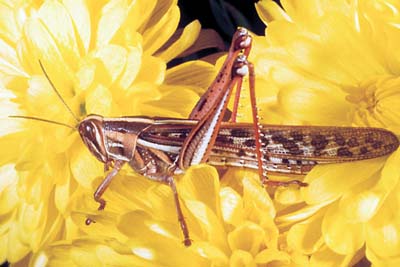To save the Web-optimized images shown below to your hard drive:
|
Click to access Display and Print quality images. |
|
Click to access Display and Print quality images. |
Copyright © 2005 University of Florida
American grasshoppers eat irregular holes in leaf tissue. Much of the feeding by adults occurs on forest, shade, and fruit trees. The nymphs, however, feed on a large number of grasses and broadleaf plants and both wild and cultivated corn is especially attractive to this species. When the population reaches a high density, it can strip vegetation of leaves. More commonly, grasshopper feeding results in plants with a ragged appearance. When the late-season crop of collards in the southeast U.S. is harvested mechanically, American grasshoppers may become incorporated into the processed vegetables. Although most grasshoppers can be kept from dispersing into crops near harvest by treating the periphery of the crop field, it is much more difficult to prevent invasion by American grasshoppers because they may fly over any such barrier treatments. Foliar applications of insecticides will suppress grasshoppers, but they are difficult to kill, particularly as they mature. Land management is an important element of population regulation. Grasshopper densities tend to increase in large patches of weedy vegetation that follow the cessation of agriculture or the initiation of pine tree plantations. In both cases, the mixture of annual and perennial forbs and grasses growing in fields that are untilled seems to favor grasshopper survival, with the grasshoppers then dispersing to adjacent fields as the most suitable plants are depleted. However, as abandoned fields convert to dense woods or the canopy of pine plantations shades the ground and suppresses weeds, the suitability of the habitat declines for these grasshoppers.
Images
To save the Web-optimized images shown below to your hard drive:

American grasshopper, Schistocerca americana.
(Photographer: J. Capinera, University of Florida)
Click to access Display and Print quality images.

American grasshopper, Schistocerca americana, nymphs.
(Photographer: J. Capinera University of Florida)
Click to access Display and Print quality images.
Copyright © 2005 University of Florida